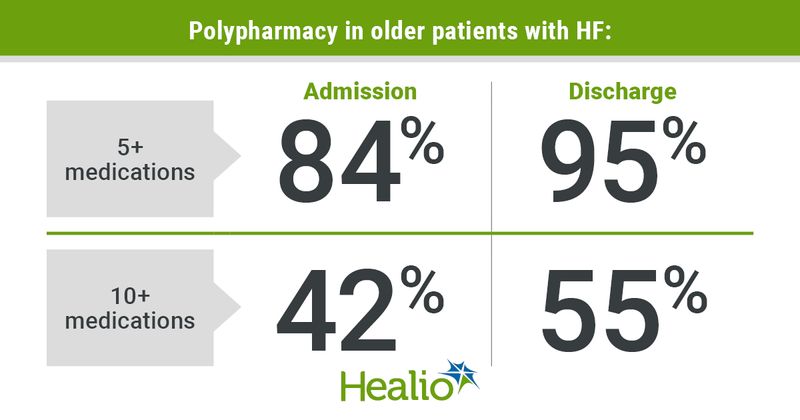Polypharmacy significantly increased in HF hospitalizations from 2003 to 2014
Polypharmacy, or the condition of taking a high burden of medications, is common in hospitalized patients with HF at admission and discharge, and has increased from 2003 to 2014, researchers found.

“The objective here was to show that almost all heart failure patients contend with polypharmacy, and hopefully generate a greater appreciation of this concept among the various specialties that care for adults with heart failure,” Parag Goyal, MD, MSc, FACC, assistant professor of medicine in the division of cardiology and director of the HF with preserved ejection fraction program at Weill Cornell Medicine, told Healio. “These findings support the importance of thinking very carefully about every medication that we’re recommending and making sure that the right medications are taken by the right patient at the right time.”

Goyal added that this concept of polypharmacy has become more important, especially as new medications become available for the treatment of HF.
“As these [new] agents become available and we prescribe all these agents, it’s important to start thinking about the inadvertent negative consequences of a rising number of medications that patients take,” Goyal said in an interview.
Data from REGARDS study
In this study, Ozan Unlu, MD, chief resident at NewYork-Presbyterian Hospital and instructor in medicine at Weill Cornell Medicine, and colleagues analyzed data from 558 patients (median age, 76 years; 44% women; 34% Black) from the Reasons for Geographic and Racial Differences in Stroke (REGARDS) study aged 65 years and older. Patients had adjudicated HF hospitalizations at 380 hospitals from 2003 to 2014. Researchers analyzed data from the baseline assessment, American Hospital Association annual survey database, medical charts from HF hospitalizations and Medicare’s Hospital Compare website.
Polypharmacy was examined at hospital admission and discharge. Medications were also classified as HF-related, non-HF CV-related or non-CV-related.
Most older patients with HF took at least five medications at admission (84%) and at discharge (95%), and nearly half of patients took at least 10 medications at admission (42%) and at discharge (55%). These patterns were similar in patients with HF with reduced ejection fraction and those with HFpEF.
“Polypharmacy and high medication burden is really common,” Goyal told Healio. “It’s important to start thinking about this issue and thinking about the ways it could impact our patients.”
Polypharmacy at admission increased from 25% in 2006 to 55% in 2011 to 2014 (P for trend < .0001). This was also seen at hospital discharge (41% to 68%; P for trend < .0001). Trends were similar when HFrEF and HFpEF were assessed separately, although the numerical increase was higher in patients with HFpEF.
“Polypharmacy is becoming an increasingly common issue,” Goyal said in an interview. “Unless we are aware of this concept of polypharmacy and unless we start incorporating the issue of polypharmacy into our decision-making, I do worry about inadvertently causing harm to some of our patients.”
Non-CV medications increased the most at admission and discharge compared with CV medications.
“As a heart failure doctor, I don’t take care of heart failure; I take care of patients with heart failure,” Goyal told Healio. “These patients often have other conditions on top of heart failure, so to ensure the best patient care, it’s important to review all the medications that a patient is taking to provide comprehensive care, especially since harmful interactions can occur from heart failure medications as well as non-heart failure medications. All should be relevant if our goal is to ultimately improve outcomes.”
‘The right polypharmacy’

In a related editorial, Rachel Denny, DO, fellow in the division of geriatric and palliative medicine at University of Michigan in Ann Arbor, and Scott L. Hummel, MD, MS, associate professor at the University of Michigan and section chief of cardiology at VA Ann Arbor, wrote: “It is important to note that guideline-directed medical therapy for HFrEF, while inherently contributing to polypharmacy, also improves outcomes in patients with HFrEF including quality of life. Closer collaboration among cardiology teams, geriatricians and pharmacists is needed for the nuanced application of algorithms, especially when treatment guidelines conflict in patients with multiple comorbidities. With these principles in mind, we can hone in on ‘the right polypharmacy’ for each patient with HF to achieve the outcomes that matter most to them.”
Reference:
For more information:
Parag Goyal, MD, MSc, FACC, can be reached at pag9051@med.cornell.edu; Twitter: @paraggoyalmd.
